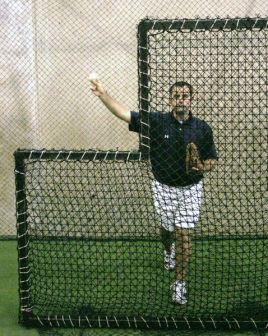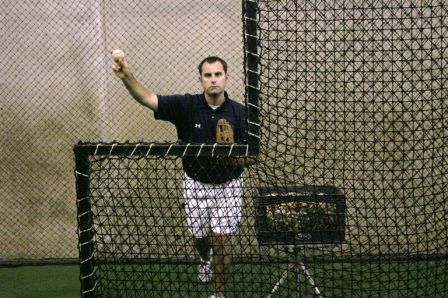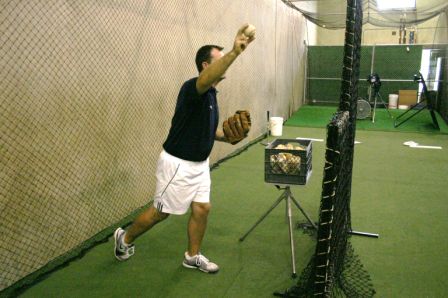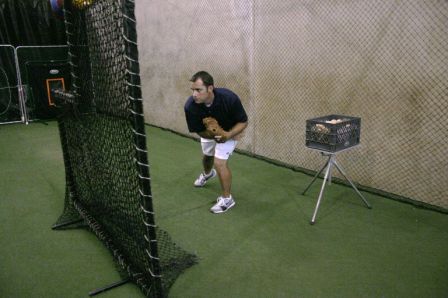What is the most dangerous position in baseball? Is it the catcher? No. Third base? Guess again. A pitcher in the aluminum bat world? Close!
All are equally dangerous, but there is one more that is much more likely to injure players and coaches!
In my experience the most severe accidents that occur in indoor/outdoor baseball facilities are to the face and upper torso of adults and players pitching batting practice behind so-called "L" screens.
The awkwardness of the L design presents a mental or neuromuscular challenge to those throwing from behind the screen. It is designed to allow a thrower to release a ball using his standard throwing motion while remaining to the side protected from a line drive hit directly back at him. 
The notch seemingly forces throwers to release the ball far to their right. This often results in an inaccurate pitch, delaying batting practice and frustrating the hitter.
This challenge is only in the thrower's mind, however, because they are not accustomed to this obstruction. Throwing behind an L screen is very uncomfortable for the recreation coach, position player tossing batting practice or the young player. It is a given that, at the beginning of every practice, it will be difficult to throw accurately behind the L screen. It will take a few throws to make an adjustment, even for an experienced batting practice pitcher. Most of all, a prudent coach will train other players AND COACHES to use a specific throwing method to minimize the chances of injury.
Maximum safety requires that the body remain totally behind the upright leg of the "L" with only the arm exposed during the throw. The body's deceleration or follow through process will carry the arm and torso behind the "L" after the ball leaves the hand and before it arrives within the batters reach. The correct release and follow through motion is shown in the pictures.
Duck and cover doesn't work
There are two recurring problems that I have observed over the years with batting practice screens: First, that the ball bucket is placed too close in front of the pitcher, which doesn't leave him enough room to complete his follow-through, and second, that pitchers believe they can duck behind the L after they throw the ball.
The solution to the first problem is simple: move the bucket behind the pitcher. Incorrect positions from the front and side are shown in the two photographs below. 

The correct positioning is shown in the picture below with ball bucket well behind and thrower extended to and behind the screen.
The solution to the second problem is more complicated. I do not believe anyone throwing behind an L screen has not experienced at least one brush with serious injury. Most of the serious injuries to batting practice pitchers are to those who incorrectly believe they can duck behind the L in the split second after throwing a pitch and before the batter hits the ball. This injury-avoidance technique simply does not work. The seriousness of the injuries a batting practice pitcher can sustain should never be underestimated. I know of numerous players and coaches who have suffered painful and serious injuries, from face fractures to cuts requiring stitches to the permanent loss of vision in an eye, and, this year, tragically, even death (during the last week of April 2009, a college coach in Virginia and a nine-year-old in New Jersey were killed throwing batting practice).
Feeling remorse on the way to the hospital is too little, too late. I personally have provided first aid for many a messy eye injury. As I'm sure many players, coaches and parents are aware of, baseball injuries involve either a band-aid or a towel to stop the bleeding!
"Duck and cover," to borrow a phrase from the 1950's, is considered a standard, if not unconscious, practice for an amazing majority of batting practice pitchers I have seen over the years. As in many aspects of baseball, people too often assume they know much more than they do. When I have approached them to provide coaching, as remarkable as it seems, they are often offended or under the allusion that they are throwing correctly. In our academy I have even resorted to videotaping them to make my point.
I have concluded that reason batting practice pitchers "duck and cover," is simply embarrassment. It is hard to correctly throw behind L screens, especially without practice. Continually throwing in the dirt, outside the strike zone or hitting the batter generates a lot of loud criticism from the players. The easy way out is to move away from the L and throw as if the screen was not there.
Surprisingly many serious injuries occur to adults who are coaching very young children. In the spring of each year they rely on last year's experience. Last year's players were younger and not as strong. They also feel safe using the "duck and cover" method style of throwing because last season they beat the odds; nothing happened to them. Again, I can't emphasize enough that this does not work. Even advanced coaches get tired after throwing 150+ pitches in batting practice, and, when they do, they get careless from the fatigue, do not finish their pitching motion, and end up failing to keep their bodies behind the screen.
Here is why the duck and cover approach does not work. A baseball traveling at 60 mph takes less than ½ second to fly the 46 feet from the pitching mound to home plate in Little League® baseball (which equals a ball going 85 mph thrown from a regulation distance (60'6")). Fifty percent (50%) of that time, about 2/10ths of a second, is considered pitch recognition time, as it covers 23 feet or half way to the plate. That is the limited time and distance for the eyes to communicate with the brain. That instant process results in a decision to act. The remainder of that time, 2/10ths of a second and 23 feet of distance, is devoted to the swing.
The reverse is also true. The ball can fly off an aluminum bat at speeds equal to or often exceeding that at which it is thrown. The exact same formula is true for the pitcher's protection; 2/10ths of a second for ball recognition, 2/10ths of a second for the pitcher to return to an upright position, raise his glove and catch the ball or be hit by it. This is why at Pinkman Baseball training we are so emphatic about pitching mechanics so that they finish their delivery in a proper fielding position
What makes the batting practice pitcher even more vulnerable to injury is that they rarely throw from the mound - whether it is 46 feet away, as in youth baseball, or 60 feet, six inches, as in levels higher than Little League. That means, of course, that the time they have to react and either catch the batted ball or avoid it is even less than the proverbial "blink of an eye."
Risk management critical
Failure to maintain L screens in excellent condition in batting cages dramatically increases the exposure of programs to costly lawsuits. In my visits to fields it is not unusual to see tattered nets, full of holes, strung up with cord. The structure is often damaged or broken, pitifully taped together. A replacement pillowcase net that slides over the top of the structure which provides double netting protection is a good investment at around $150.
I also encourage parents to inspect the L screens before allowing your kids to throw batting practice. Hold the program accountable in advance or, if necessary, pay for the replacement out of your own pocket. You don't want to be thinking on your way to the emergency room that there is something you could have, and should have, done to prevent a serious injury. Please don't become another injury statistic.
I personally continue to offer instruction on throwing behind "L" screens.
Some coaches are a bit put off by "unnecessary" training. Many of them took that instruction lightly or not at all silently, protesting that, up to that point, they had never been hurt. Such an attitude is remarkably foolish. Indeed, the casual, even cocky, manner in which many coaches approach this subject is frightening!
Earlier this year, after noticing many coaches at risk in league that was renting our facility, we sent out a newsletter with this message. The newsletter wasn't out 24 hours before one of their coaches was hit in the face with a ball.
Think this is too basic? Here's a challenge! Set up a video camera behind your cage as if you were videoing the batter. But video your L screen throwers. Do not tell the thrower you are videoing him. The both of you will be in for a real shock!
If you think I am being too direct, I offer no apologies. If this article prevents even one injury, I have done my job.








